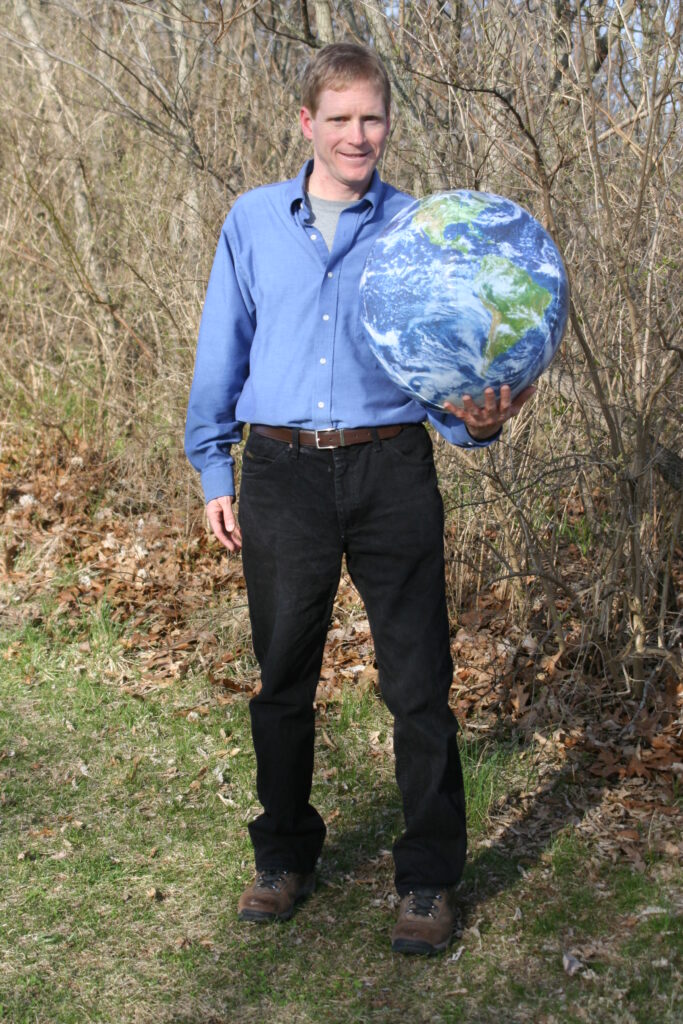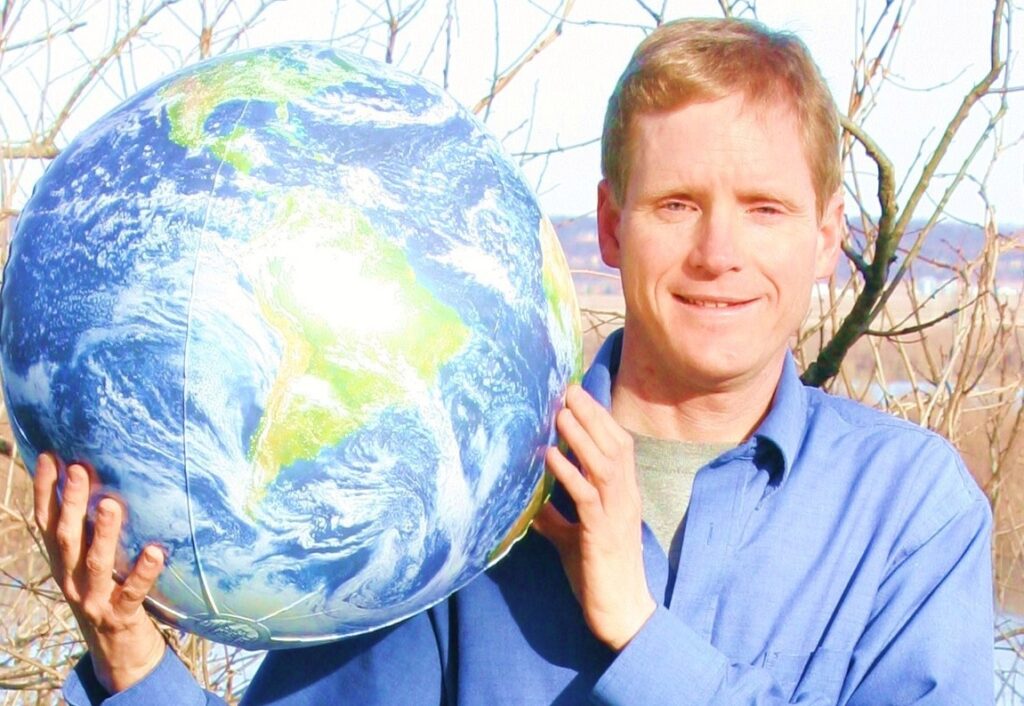
“Yes, we do need hope…But the one thing we need more than hope is action.
Once we start to act, hope is everywhere. So instead of looking for hope, look for action.
Then, and only then, hope will come.”
– Climate Activist Greta Thunberg at her 2018 TED Talk
This is the toughest blog for me to write. In fact, I devoted the last year to writing about my life story and blogging for years before that. I knew it was vital for me to write this blog, but I dreaded writing it. For the past 23 years, I have felt that environmentalists, climate advocates, progressives and Democratic leaning voters were not smart about electing Presidential, state level, and local candidates who would protect our environment, planet, and our democracy.
This is a very painful blog to write, but I feel like I must share but to share my story. Hopefully, someone can learn from my disappointment and letdown I felt from environmental and climate Democratic voters who allowed awful candidates for President and other elected offices win.
The first post in this blog series, My 1980s childhood in Missouri to witnessing 2000 Presidential Election in Florida. Part 2, my story from 2001 to 2007. For Part 3, my life in 2007, Loss of a friend, Leaving the Everglades, and finding my passion for climate action.
Part 4: Healing from grief and Taking Climate Action in Oregon and Missouri 2009-2016
Finding Healing from Grief on Hawaii’s Big Island in October and early November 2008
In late May of 2008, I returned to work at Crater Lake National Park for the summer. Soon after I arrived in the park, I mentioned to my superiors that I wanted to give a ranger program about climate change. My Crater Lake supervisor, Eric Anderson, and the lead interpretive ranger, David Grimes, supported and encouraged my idea. I just did not feel like I knew enough or was brave enough to do such a program. It would take me three more years before I felt courageous and had enough knowledge to give my climate change evening program at Crater Lake.
During summer of 2008, I focused on my ranger programs, including adding a sunset guided ranger hike up Watchman’s Peak. I was still in a fog and feeling raw from losing my mentor Steve Robinson the previous October. In autumn 2008, Eric Anderson persuaded me to give ranger programs to the school groups visiting Crater Lake during the Fall Classroom at Crater Lake program. The school groups ranged from 5th grade to high school.
I quickly discovered giving ranger talks to school groups was not my thing. The students were frequently rambunctious since they were outside of their school for the day. I could relate because I was a boisterous brat when I was a kid, especially on school field trips. Many of the teachers were either overly demanding or aloof. At the same time, I saw fantastic teachers in action the way they successfully guided their students. I marveled at the great teachers and I doubted I had the adept skills to manage a classroom like them. The adult chaperones were often annoying. I would ask the students a question and the adults would jump in to answer.
Crater Lake is so beautiful, and we had a lot of gorgeous weather that fall. However, I could not wait for my commitment for Classroom at Crater Lake to be over. I still grieved over the loss of my friend and mentor Steve Robinson. I needed to go somewhere to do some healing. Fortunately, my friends John and Jeanette Broward invited me to come visit them on the Big Island of Hawaii. They were close friends of Steve and could relate the emptiness I felt at that time.
I visited the Big Island of Hawaii for 8 days around the end of October and the beginning of November 2008. During the trip, Jeanette told me that Native Hawaiians believed that each of the islands has a theme. They thought the theme of the Big Island was a place of healing. The Big Island had tranquil Pacific Ocean beaches, imposing volcanic mountains that destroyed yet created more land, and towering waterfalls on the Hilo side. If one was open to it, the Big Island was a place that can provide renewal for one’s heart, mind and soul.
That warmed my heart to hear that. John and Jeanette lived in Volcano, which is right next to Hawaii Volcanoes National Park. John was a law enforcement ranger at the national park. On his day off, John took me hiking inside the national park for the day. During our hike, he told me that he had a recent dream where he had a conversation with Steve. In the dream, Steve was smiling and laughing. He told John that he was happy and doing great.
I really made the most of this trip. John and Jeanette took me to go snorkeling at a coral reef not far from their house. I tried parasailing and surfing near Kailua-Kona. I was terrible at surfing. It felt like a huge life victory when I was able to successfully stand up one time on the surfboard and ride a small wave. I visited all the national park sites on the island that were sacred heritage sites for the Native Hawaiians.

John and Jeanette arranged for me to go birdwatching with Jay Robinson, one of the top birding experts working at Hawaii Volcanoes National Park. He showed me endemic native colorful Hawaiian bird species such as the ‘I‘iwi, ‘Apapene, ‘Amakihi, ‘Oma’o, ‘Elepaio, Nēnē (Hawaiian goose), and other birds.
In my own exploring, I drove to the southernmost point of the Big Island, South Point Park. This is the southernmost point of the U.S. It’s one of the windiest places in the U.S. Thus, it was great to go there feel the winds, the big jagged cliffs overlooking the ocean and see the multiple wind turbines providing a portion of the electricity to the island.
I journeyed to the far northern part of the Big Island to see the Pololū Valley Lookout. I hiked down the tall sloping ridge to the beach and nearly had the whole area to myself as I walked. I made the most of this vacation and exploration around the Big Island. In my state of traveling bliss and soaking up the healing spirit of the Big Island, my friend John asked me a question that reminded me that I had a role to play as a responsible citizen.
When I hiked with John at Hawaii Volcanoes National Park, he inquired, “Did you vote by mail in the upcoming Presidential election?”
With the loss of Steve and my bitterness I still felt over the outcomes of the 2000 and 2004 elections, I admitted to John that I had not voted. John was flabbergasted and was disappointed with me that I had not voted. There was a lot of excitement across the U.S. that Barack Obama could win and become America’s first Black President. I shared with John that after what I experienced in the previous Presidential elections, I just could not get my hopes up. I was rooting for Barack Obama. I liked his message of ‘Hope and Change.’ I just felt hopeless at that point.

The Big Island provided the healing and renewal I needed. John’s question tugged at me that I needed to return my involvement in politics to take care of our natural environment and planet.
My long seasonal job at Crater Lake in 2009 with lots of traveling in between
For that winter of 2008-09, I returned to my hometown of St. Louis, Missouri to visit my parents, sisters, and their families. I got a seasonal job working at REI in mid November helping customers in the store shopping for holiday gifts and outdoor items for winter vacations. Sadly, the Great Recession dominated the economy in January 2009. The seasonal employees that were hired for the Christmas shopping season, such as me, were the first employees laid off.
I needed another job. The Spring Classroom at Crater Lake started in mid-March, and they needed rangers to guide the school programs. The manager of the Classroom at Crater Lake Program, Linda Hilligoss, was happy to have me return to Classroom at Crater Lake.
During the drive from St. Louis, MO to Crater Lake National Park in Oregon, I visited friends. I stayed with my college friend Brent Isaacs and his parents in Tulsa, Oklahoma. I met with Tess, a former Crater Lake boat captain, in Phoenix, Arizona. I then drove west I-10 and camped for a couple of nights in Joshua Tree National Park, California. It was a fun park to hike and explore. The Joshua trees were shorter and more stubby looking desert palm trees, not much taller than me. They still had a charming and majestic quality that was fun to take photos of them.
I then spent several nights visiting my friend Cherie Barth at Sequoia National Park. I knew Cherie from when we both worked in Flamingo in Everglades National Park years ago. It was magical to spend a couple of days hiking among the huge sequoia trees with their bright orange bark and their massive girth that seemed to extend to the heavens.
I arrived at Crater Lake on March 20th. I had a great spring working at Classroom at Crater Lake. I enjoyed leading the snowshoe hikes for the school groups. The snowshoe hikes were much more fun than the fall programs. I told the adult chaperones that if they jumped in to answer the students’ questions that they would be pelted with snowballs from the students. A couple of times when the adults jumped in to answer, the students grabbed their snowballs. They were getting ready to cock their arms to just pummel the adult with the snowballs. I then stepped in to save the adult’s life and they got the point to be quiet to let the kids answer the questions.

During the snowshoe hikes, I found a big snowy hill for the students to slide down. I always went first to show the students how to slide down the snow. Several occasions, the teachers and adults could not help themselves and slid down the snow. At the end the of program, I would line up the students at the top of a tall snowy embankment. I took off my snowshoes and was about 20 yards away from them. I stood on the paved road at Rim Village and dared them to hit me with a snowball. It was a fabulous workout to dodge the snowballs. The students were hilarious trying to hit me. One time a kid yelled at me, “Today is your funeral, mister!”
Because I planned to work a long season at Crater Lake from mid-March to the end of September, Crater Lake National Park had to lay me off for two weeks at the last week of May and the first week of June. This prevented the park from exceeding the number of hours and weeks I could work as a seasonal employee for the federal government during a fiscal year. For this two-week vacation, I decided to visit the national parks in Washington State.
For those two weeks, I camped and visited Olympic, North Cascades, and Mt. Rainier National Parks. I basically had sunny and warm weather the whole time. It was perfect weather for sightseeing, photography, hiking, and admiring the natural beauty of those places. Plus, on the drive up to Washington State, I stayed with my friends Gary and Melissa Martin and their daughter Shelby in Salem, Oregon. We visited Silver Falls State Park, which is less than an hour drive east of Salem. We spent the day hiking on the Trail of the Ten Falls. This is a loop trail over 7 miles long, with four water falls one can hike behind. The waterfalls are stunning, ranging from 27 to 178 feet. This was a state park that was so beautiful that it should be a national park.
In the second week of June, I returned to Crater Lake National Park to give my ranger programs for the summer. During that summer, I became lifelong friends with fellow seasonal park rangers Graham Hetland and Aubrey Shaw. They lived permanently in Ashland, Oregon where they attended Southern Oregon University. Graham’s mother lived in Ashland. They needed someone to housesit for his mom, Barbara, for the winter. Barbara planned to go on a cross country road trip in a RV. Thus, they wanted someone to watch her home and her friendly cat, Poppy. I planned to return to St. Louis, but they persuaded me to housesit for their mom.
Grabbing “Climate Change Comedian” Title while living in Ashland, Oregon in the fall 2009
I moved from Crater Lake to Ashland, Oregon in October 2009. Ashland is a beautiful small city in southern Oregon nestled right against the Siskiyou Mountains. The leaves turned brilliant autumn colors while I was there. The weather had ideal Indian summer days while slowly getting cooler as the calendar immersed into fall. It was fun to walk around Ashland for exercise and take pictures of Ashland experiencing autumn. At the same time, I found myself restless. I wanted to pursue my climate change calling, but not knowing what to do about it.
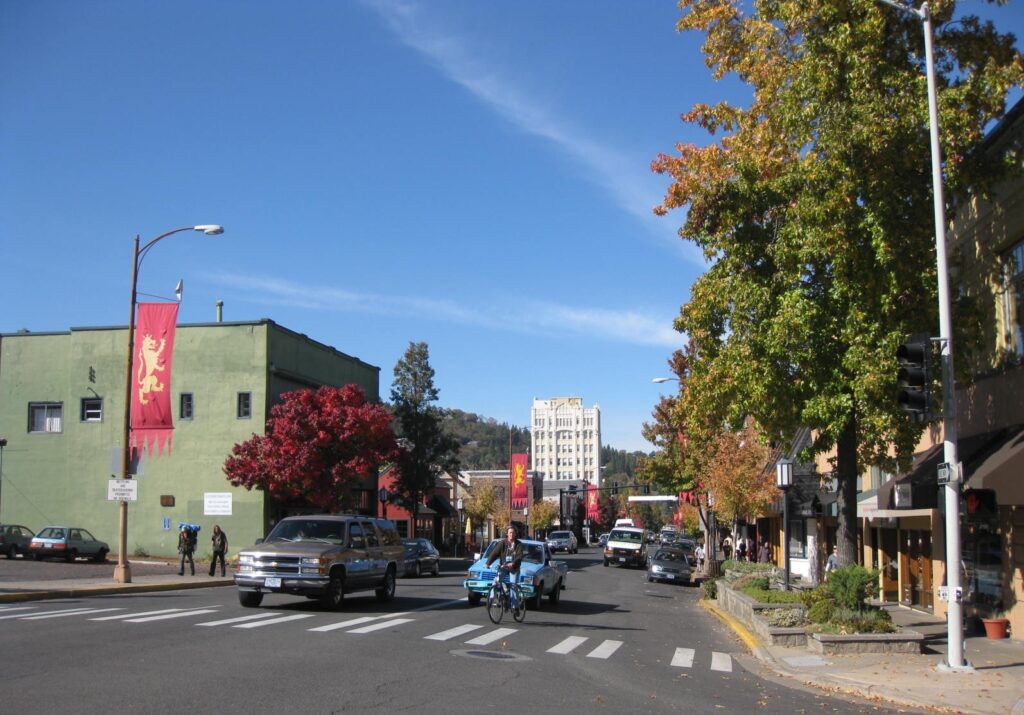
I decided to go to Southern Oregon University (SOU) and meet with Dr. Greg Jones, an SOU professor and climatologist. He specializes in the study of climate structure and suitability for viticulture. Specifically, he studies how climate variability and climate change influence grapevine growth, wine production, and quality. At that time, I was interested in attending grad school to learn more about climate change. I was eager to see if he had any advice for me. Even more, I was curious to see if maybe I could get my master’s degree studying under him at SOU.
My meeting with Dr. Jones did not go well. I shared my background of seeing climate change in the Everglades, plus watching the documentary about Al Gore, An Inconvenient Truth. He immediately let me know that he did not like Al Gore. He did not think Gore was a good spokesperson to explain to the public about climate change. That did not sit well with me because it was Al Gore and his advocacy that brought me to meet with him in his office. I left this awkward meeting I not knowing what my next step would be to pursue my climate change vision.
A few days later, I visited my friend Naomi Eklund who lived in Ashland for advice. She pressed me on what exactly did I want to do with my life. She kept pushing me harder. Finally, I snapped, “Fine! If I could do anything, I would like to be ‘The Climate Change Comedian!”
Naomi was a tough audience, but she nearly fell out of her fell out of her chair laughing. She responded: ‘That’s perfect! I want you to go home and grab that website domain name now, www.climatechangecomedian.com.’
I went home and did that. Barbara soon sent news that she did not like RVing across country. She decided to return to her home where I was housesitting in Ashland in mid November. When she moved back home, it felt awkward living in her house. Around Thanksgiving, Barbara announced that she did not want to share her home with me. My parents just moved into a new home in St. Louis. They wanted me to return home to spend the winter with them.
On December 10, 2009, I left Ashland, Oregon for a cross country drive back to St. Louis, Missouri. Like my previous road trips that year, I made the most of this trip. I visited a friend in downtown San Francisco and explored the city for a day. I then stopped by the beach in Monterey, California. Next I achieved a life goal seeing the picturesque Bixby Creek Bridge, just a few miles south of Monterey. Driving down the coast on Hwy 101, I spent the night in San Simeon, CA. The next day I achieved another dream to see Hearst Castle. From there, I drove across California to visit a friend in Death Valley National Park. From Death Valley, I traveled to Las Vegas to spend the night and walk around the city for the evening.
My next stop on this cross country trip was to visit my friends Steve and Melissa in Flagstaff, Arizona. Steve worked as a back country law enforcement ranger at Grand Canyon National Park. While chatting with Steve during a hike of a box canyon just south of Sedona, he asked me if I would be interested in hiking to the bottom of the Grand Canyon during this trip. I am always up for an adventure, so I said, “Yes!” The next thing I know, we were at the store buying groceries for this hike and Steve lent me his backpack and other gear. I hiked from Canyon Village on the south rim to the bottom of the Grand Canyon on December 20th. Steve arranged for me to spend that night at the Phantom Ranch Ranger Station at the bottom of the Grand Canyon.
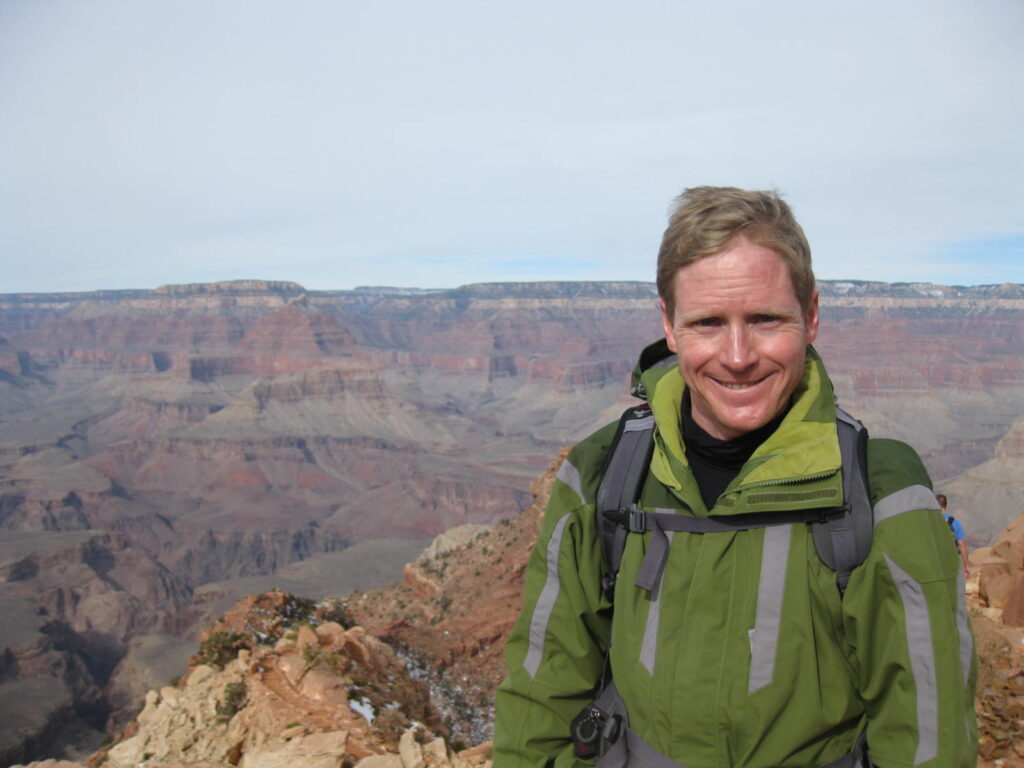
I hiked back up from bottom of the Grand Canyon on December 21st. On December 22nd, I started the long drive to St. Louis. I faced winter weather snowing conditions driving up I-44 in Missouri on the afternoon of Christmas Eve. However, I arrived at my parents’ new house in St. Louis that evening to celebrate Christmas with my family just in time. After I settled into their home for the winter, I had to figure my next step with this “Climate Change Comedian” title.
During that winter in St. Louis, Naomi advised me to fully develop my website and create my own climate change PowerPoint that I would use for my presentations. Early in 2010, I developed my first climate change PowerPoint, “Let’s Have Fun Getting Serious about Climate Change.” I showed that PowerPoint to friends and family in the St. Louis. A family friend helped me launch my climatechangecomedian.com website that is still active to this day.
Finding my groove as a climate change speaker
During the early months of 2010, my sisters in St. Louis wanted me to speak at my nieces’ and nephews’ schools. My younger sister first booked me to speak at my nephew Sam’s second grade class in St. Charles, Missouri on February 5, 2010. This was my first presentation outside of working as a ranger in the national parks.
For this presentation, I brought my inflatable Earth Ball, which is my symbol for caring and appreciating our planet. I used an Earth Ball for years in my Everglades and Crater Lake ranger talks. The symbol of me holding an Earth Ball is the image I use for my website and all the social media platforms I use (Facebook, Twitter, and LinkedIn). The young students liked seeing the inflatable Earth during my talk.
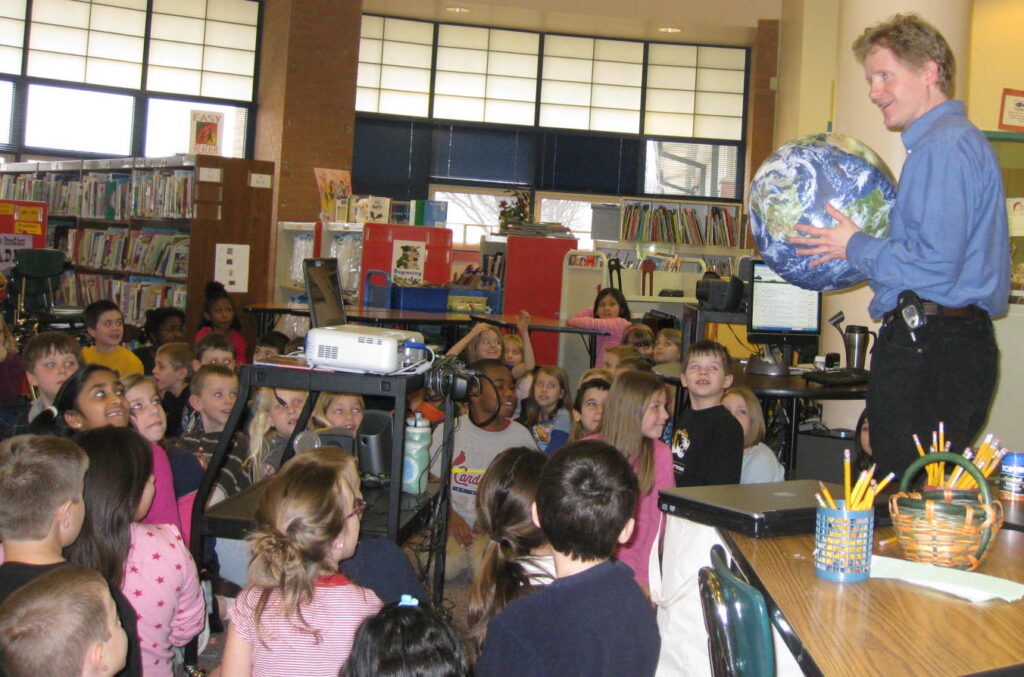
Exactly one month later, March 5, 2010, I spoke at oldest niece and goddaughter Rachel’s seventh grade class in St. Louis. This talk was a breakthrough for me because this was the first time that I spoke about climate change in a public talk. I showed the average annual snowpack had gone down over the last several decades at Crater Lake. I defined global warming as humans trapping more carbon dioxide and greenhouse gases in our atmosphere. As a result, the average temperature of the planet has increased since the Industrial Revolution started in 1880.
I then talked about how climate change could cause problems with less snowpack, greater heat waves, and sea level rise. I then urged them to reduce the threat of climate change by recycling, unplugging voltage vampire appliances in their homes, and turning down the heat by putting on a sweater or snuggle blanket. Hopefully, this message on climate change somehow planted a seed in the minds with these students. I will always be grateful that my older sister, my oldest niece, her classmates, and her school gave me this opportunity to talk about climate change for the first time in a public talk.
At Crater Lake National Park that summer, I gave my climate change PowerPoint informally to some of my ranger friends one evening and I shared it with a few other ranger friends. During my cross-country drive from Crater Lake National Park, Oregon to St. Louis, Missouri in November 2010, I showed this PowerPoint twice. I shared it to some ranger friends in Page, Arizona and to my college friend Brent in Oklahoma City, Oklahoma. These friends gave me some helpful tips and feedback to improve my talk.
In 2011, things started happening for me as a climate change advocate. After I returned to St. Louis for the winter of 2010-11, I wanted to improve my skills as a public speaker and climate change communicator. I joined a local Toastmasters group, South County Toastmasters, in January 2011. Over the next five years, I gave 20 climate change speeches to this local Toastmasters Club. My fellow Toastmasters voted for me as “The Best Speaker” for 8 of these speeches.
In March 2011, I had the fortuitous luck to be offered a job to work at the St. Louis Science Center’s temporary Climate Change exhibit. This was one of the few climate change museum exhibits in the United States at that time. While working there, I met St. Louis businessman Larry Lazar. We decided to co-found the St. Louis Climate Reality Meet Up in December 2011 (now known as Climate Meetup-St. Louis).
This Meet Up group is where I met Tanya Couture. She attended our events beginning in January 2012. We started dating in February 2013. We got married on November 1, 2015. As I joke in my climate talks, ‘Join the climate movement, you might meet the person of your dreams!’
In August 2011, I gave my first climate change ranger evening program at Crater Lake National Park, called The Good, The Bad, and The Ugly. I performed this ranger talk at Crater Lake for the next five summers, up until 2017. Over the past 13 years, I ended up giving over 200 climate change talks in 12 U.S. states, Washington D.C, and Ottawa, Canada.
One of those speeches was at the Shrine of the Ages Auditorium at Grand Canyon National Park to an audience of over 200 park visitors and park staff in May 2013. Due to my ranger connections of working in the national parks for 25 years, my friend Pete invited me to give this talk.

Finding success and fulfillment as a climate change organizer
Besides speaking and hiking to the bottom of the Grand Canyon, I had many other adventures and exciting moments as a climate change organizer. In 2012, I attended a Climate Reality Project Training led by former Vice President Al Gore to become a Climate Reality Leader. I loved attending that training and was honored to be a mentor for 8 addition trainings to guide others become effective Climate Reality leaders. At the May 2015 Cedar Rapids Training in front of the group of my fellow mentors, I personally asked Al Gore how to best respond to his critics.
After I became The Climate Change Comedian, I created some YouTube videos with my wife Tanya, my mom Fran Ettling and my dad LeRoy Ettling. Comedy Central’s Tosh.o noticed these videos. This TV show flew my mom and I to Los Angeles in April 2016 to appear on their episode airing on August 2, 2016. I never dreamed that when I gave myself that title that it would be on a TV show seen by millions of people. My 2016 guest appearance met the satisfaction of Tosh.o because they invited me back for a second time for their November 10, 2020 episode.
In April 2012, Carol Braford, the St. Louis Chapter Leader for Citizens’ Climate Lobby (CCL) recruited me to volunteer for CCL. I immediately became deeply committed to CCL. While working as a park ranger at Crater Lake National Park during the summer of 2012, I reached out to various climate and environmental advocates in the Ashland, Oregon area. As a result of these interactions, I co-founded the Southern Oregon CCL chapter in 2013 that still regularly meets in Ashland. In 2013, CCL inspired me to write 10 published editorial opinions, two in the St. Louis Post-Dispatch and eight in newspapers throughout Oregon.
CCL inspired me to attend 8 of their Washington D.C. conferences from 2015-19 to lobby Congressional offices on Capitol Hill. I loved attending lobby meetings with fellow CCL volunteers to urge Congressional offices to support federal climate legislation. As a climate change organizer, public speaker, and writer, it felt like 2011 to 2019 were very productive years for me. My lowest point though was the Presidential election of 2016. It was an extremely painful time for me. I felt like I was reliving the election of 2000 all over again.
Part 5 of this blog will focus on my painful experience of the election of 2016.
